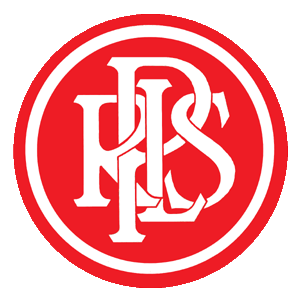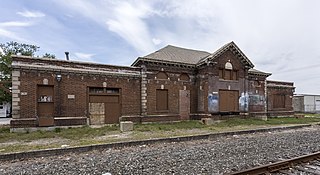
The Delmarva Peninsula, or simply Delmarva, is a large peninsula on the East Coast of the United States, occupied by the vast majority of the state of Delaware and parts of the Eastern Shore regions of Maryland and Virginia. The peninsula is 170 miles (274 km) long. In width, it ranges from 70 miles (113 km) near its center, to 12 miles (19 km) at the isthmus on its northern edge, to less near its southern tip of Cape Charles. It is bordered by the Chesapeake Bay on the west, Pocomoke Sound on the southwest, and the Delaware River, Delaware Bay, and the Atlantic Ocean on the east.

Delmar is a town in Sussex County, Delaware, United States, on the Maryland border along the Transpeninsular Line. Its motto is "The Little Town Too Big for One State." The population was 1,597 at the 2010 census, an increase of 13.5% over the previous decade. It is part of the Salisbury, Maryland-Delaware Metropolitan Statistical Area and a suburb of Salisbury, MD. When added with Delmar, Maryland, the total population of the town was 4,600 at the 2010 Census.
The Pennsylvania Railroad was an American Class I railroad that was established in 1846 and was headquartered in Philadelphia, Pennsylvania. It was so named because it was established in the Commonwealth of Pennsylvania.

The Central Railroad of New Jersey, also known as the Jersey Central or Jersey Central Lines, was a Class I railroad with origins in the 1830s. It was absorbed into Conrail in April 1976 along with several other prominent bankrupt railroads of the Northeastern United States.

The Pennsylvania-Reading Seashore Lines was a railroad that operated in southern New Jersey in the 20th century. It was created in 1933 as a joint consolidation venture between two competing railroads in the region.
The Belvidere-Delaware Railroad was a railroad running along the eastern shore of the Delaware River from Trenton, New Jersey north via Phillipsburg, New Jersey to the small village of Manunka Chunk, New Jersey. It became an important feeder line for the Lehigh Valley Railroad's join to the Central Railroad of New Jersey, which was constructed into Phillipsburg, NJ at about the same time. This connected Philadelphia and Trenton, NJ at one end of the shortline railroad to the rapidly growing lower Wyoming Valley region, and via the Morris Canal or the CNJ, a slow or fast connection to New York City ferries crossing New York Harbor from Jersey City, NJ. In 1871 the CNJ leased various railroads in Pennsylvania, most from the Lehigh Coal & Navigation Company allowing the CNJ to penetrate to the upper Wyoming Valley, over some stretches, competing directly with the Lehigh Valley Railroad and with the Lehigh Canal and the trunk road connection of the Belvidere Delaware Railroad to New York became less profitable since Philadelphia connected more easily to Northeastern Pennsylvania thereafter without needing a double-crossing of the Delaware River; a general revenue decline ensued, leading to the Pennsylvania Railroad acquiring the rights, where it served as part of the Pennsylvania Railroad (PRR) system, carrying mainly anthracite coal and iron ore from northeastern Pennsylvania to population centers along the coast.

The Eastern Shore Railroad, Inc. was a Class III short-line railroad that began operations in October 1981 on the 96-mile (154 km) former Virginia and Maryland Railroad line on the Delmarva Peninsula. The line ran between Pocomoke City, Maryland, and Norfolk, Virginia, interchanging with the Norfolk Southern Railway at both ends.

The Little Creek-Cape Charles Ferry was a passenger ferry service operating across the mouth of the Chesapeake Bay from the 1930s until 1964. Known also as the Princess Anne-Kiptopeke Beach Ferry or Little Creek-Kiptopeke Beach Ferry, the service connected Virginia Beach, Virginia with Cape Charles on the Eastern Shore of Virginia. Departures from and arrivals to Cape Charles were matched with times of Pennsylvania Railroad passenger trains such as the Del-Mar-Va Express and the Cavalier that operated the length of the Delmarva Peninsula.

The Delair Bridge is a railroad bridge with a vertical-lift section that crosses the Delaware River between Philadelphia, Pennsylvania, and Pennsauken Township, New Jersey, just south of the Betsy Ross Bridge. The two-track bridge is part of Conrail Shared Assets Operations and is jointly used by Norfolk Southern Railway and CSX Transportation freight trains, as well as by the New Jersey Transit Atlantic City Line service.

The Bay Coast Railroad operated the former Eastern Shore Railroad line between Pocomoke City, Maryland, and Norfolk, Virginia. The railroad interchanged with the Delmarva Central Railroad in Pocomoke City and Norfolk Southern in Norfolk; the interchange in Pocomoke City had been with Norfolk Southern prior to December 2016, when the Delmarva Central Railroad leased 162 miles (261 km) of Norfolk Southern track on the Delmarva peninsula.

The Harrisburg Subdivision is a railroad line owned by CSX Transportation in the U.S. state of Pennsylvania. The line is located in the city of Philadelphia, connecting Greenwich Yard and the Philadelphia Subdivision with the Trenton Subdivision along a former Pennsylvania Railroad line. Much of the Harrisburg Subdivision is the High Line or West Philadelphia Elevated along 31st Street over the 30th Street Station area.
The Shellpot Branch is a former Pennsylvania Railroad/Penn Central through-freight railroad owned and operated by Norfolk Southern since its acquisition, along with CSX Transportation, of Conrail in 1999. The branch allows Norfolk Southern, since the opening of a new bridge in 2001, to bypass the city of Wilmington, Delaware and allows direct access to both the Port of Wilmington and the New Castle Secondary, which connects to the Delmarva Subdivision of the Delmarva Central Railroad that runs to Central Delaware, Maryland, and Virginia's Eastern Shore. Both ends of the branch connect with Amtrak's Northeast Corridor and, like all of the PRR's through-freight lines, was electrified from 1935 until the Conrail era. The line was originally built doubly tracked, but was subsequently converted to single track.

The Central New York Railroad is a shortline railroad operating local freight service along ex-Southern Tier Line trackage in the U.S. states of New York and Pennsylvania. The line begins at Port Jervis, following the Delaware River to Deposit and the Susquehanna River from Lanesboro, where it passes over the Starrucca Viaduct, to Binghamton. It is a subsidiary of the Delaware Otsego Corporation, which also owns the New York, Susquehanna and Western Railway, operator of through trains over the line.
The Pomeroy and Newark Railroad was a predecessor of the Pennsylvania Railroad in the U.S. states of Delaware and Pennsylvania. It connected Pomeroy, Pennsylvania to Newark, Delaware, and has mostly been abandoned.

Union Station is a historic railway station located at Salisbury, Wicomico County, Maryland, United States. It was constructed in 1913–14, near the junction where the New York, Philadelphia & Norfolk Railroad intersected with the Baltimore, Chesapeake and Atlantic Railroad in the center of Salisbury. Both railroads became part of the Pennsylvania Railroad (PRR). It has a 1+1⁄2-story, Flemish bond brick main block covered by a medium-pitched hip roof sheathed in slate, with single-story wings. From the 1920s to the 1950s, the PRR ran several passenger trains a day, including the Del-Mar-Va Express, through the station, north–south from Philadelphia to Cape Charles, Virginia.
The Baltimore, Chesapeake and Atlantic railroad, nicknamed Black Cinders & Ashes, ran from Claiborne, Maryland, to Ocean City, Maryland. It operated 87 miles (140.0 km) of center-line track and 15.6 miles (25.11 km) of sidings. Chartered in 1886, the railroad started construction in 1889 and cost $2.356 million ($2022=71,055,000).

The Delaware, Maryland, and Virginia Railroad is a defunct American railroad that operated passenger service from Broad Street Station in Philadelphia, Pennsylvania to Franklin City, Virginia. At the latter city, steamship connections could be made to Chincoteague, Virginia on the Atlantic Ocean-side exterior islands. The railroad was formed in 1883 through a consolidation of the Junction and Breakwater Railroad and the Breakwater and Frankford Railroad. The Philadelphia, Wilmington and Baltimore Railroad took control in March 1891 after the Delaware, Maryland, and Virginia Railroad approached default on two mortgages totaling $600,000. The Delaware General Assembly met with Delaware, Maryland, and Virginia Railroad directors and those of the Philadelphia, Wilmington, and Baltimore Railroad in order to avoid the default and keep the rail lines open. The Delaware, Maryland, and Virginia Railroad shareholders remained minority owners of the line until 1919, when they were unable to meet financial obligations, and the minority shares were sold to the Pennsylvania Railroad.
The Delmarva Central Railroad is an American short-line railroad owned by Carload Express that operates 188 miles (303 km) of track on the Delmarva Peninsula in the states of Delaware, Maryland, and Virginia. The railroad operates lines from Porter, Delaware to Hallwood, Virginia and from Harrington, Delaware to Frankford, Delaware along with several smaller branches. The DCR interchanges with the Norfolk Southern Railway and the Maryland and Delaware Railroad. The railroad was created in 2016 to take over the Norfolk Southern Railway lines on the Delmarva Peninsula. The DCR expanded by taking over part of the Bay Coast Railroad in 2018 and the Delaware Coast Line Railroad in 2019.

The Delaware Railroad was the major railroad in the US state of Delaware, traversing almost the entire state north to south. It was planned in 1836 and built in the 1850s. It began in Porter and was extended south through Dover, Seaford and finally reached Delmar on the border of Maryland in 1859. Although operated independently, in 1857 it was leased by and under the financial control of the Philadelphia, Wilmington, and Baltimore Railroad. In 1891, it was extended north approximately 14 miles (23 km) with the purchase of existing track to New Castle and Wilmington. With this additional track, the total length was 95.2 miles (153.2 km).
The Del-Mar-Va Express was a named passenger train of the Pennsylvania Railroad that at its peak went from New York City to the southernmost point of the Delmarva Peninsula, Cape Charles, Virginia. Initiated in 1926, the train's north–south passage through Delaware stood in contrast with the main passenger traffic through Delaware being a brief passage through cities in the upper reach of Delaware, mainly Wilmington. Most importantly, the train served as a more direct path from New York City and Philadelphia to Norfolk, Virginia, by way of a ferry from Cape Charles across the Chesapeake Bay to Norfolk, a path that bypassed Baltimore and Washington, D.C. This saved time in comparison to travel over PRR, Atlantic Coast Line and Norfolk & Western trains through Washington to Norfolk. The Del-Mar-Va trip, including ferry travel was 11 hours from New York; and the longer all-land route through Washington was 13 hours and 40 minutes.















